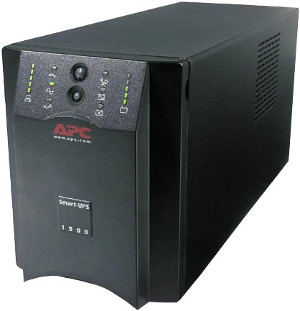The Clicking UPS

The problem
This brief write-up documents the findings from investigating why an office Uninterruptible Power Supply (UPS) clicks into over-voltage protection (AVR - Automatic Voltage Regulation) so frequently.
The UPS in question is a 2008 model (SUA1500I) Line-interactive APC Smart-UPS 1500 supplying a couple of PCs, telephones and small network switch.
This UPS frequently clicks into over-voltage protection (as witnessed by the AVR Trim on the front panel LEDs) because the mains supply often exceeds a default threshold of 253 volts.
Investigation

Hooking it up with a USB cable from its monitor port to a (Ubuntu 12.04) computer running apcupsd, and executing "sudo apcaccess|grep Volt" results in (comments added):
LINEV : 250.5 Volts # supply voltage from mains
OUTPUTV : 250.5 Volts # output voltage to devices - same as LINEV unless UPS is regulating
LOTRANS : 208.0 Volts # switch to filtered supply if supply voltage drops below
HITRANS : 253.0 Volts # switch to filtered supply if supply voltage exceeds
BATTV : 27.5 Volts
NOMOUTV : 230 Volts
NOMBATTV : 24.0 Volts
So it is apparent from the above figures that if the mains supply voltage strays outside the 208 - 253 volt range, the UPS regulates the voltage to (in our case) 224v.
Monitoring by the UPS over 24 hours it transpires that our usual mains supply voltage range is 233 - 255.

Checking with two different digital multimeters and an energy monitor, suggests the UPS readings are 3 volt higher than reality (this can possibly be calibrated within the UPS, but requires information from APC themselves).
| Volts | |
| UPS LINEV | 247 |
| Energy Monitor | 244 |
| Fluke meter | 244 |
| Clamp meter | 245 |

So the real voltage range experienced during this 24-hour window was 230 - 252 volts (a 9% variance).
Further monitoring over the course of a week detected an actual low of 223v and a high of 255v.
What to do?

This means that the UPS trim switch-over causes the output voltage to jump 29 volts from 253v to 224v and subsequently back-again. This is rather a sudden 11% voltage jump for any attached appliances.
Whilst on AVR trim, the UPS uses an internal transformer and creates heat which degrades the life of the internal components.
Ideally we would like the mains supply voltage to stay within 220 - 240 volts. But UK law still says 230v -6% +10% which is 207-253v (allowing UK average to remain at 242v without contravening the law). In fact the rules actually allow the voltage to exceed even this 207-253v window 5% of the time!
Unfortunately this is bad news for many devices, for example a Sony Vaio laptop external PSU is rated at 110-240v.
If the mains voltage regularly exceeds 253v the power distribution people should address it, if reported. But in our case this seems unlikely, so what other action can we take?
If we accept that our devices can handle slightly over 253v (which they would be subjected to anyway if they were directly plugged into our mains), then increasing the UPS HITRANS setting to 257 volts would stop most switch-overs.
/etc/init.d/apcupsd stop
apctest
Select function number: 9
Current HIGH transfer voltage setting: 253 Volts
Enter new HIGH transfer voltage (0 to cancel): 257
New HIGH transfer voltage setting: 257 Volts
/etc/init.d/apcupsd start
Well, that's stopped the clicking!
Some background info on the UK mains voltage

(Mostly derived from http://www.nottingham.ac.uk/etc/guide-voltageoptimisation.php)
Just as it was in 1960, the supply voltage to domestic properties in the UK is still nominally 240 V AC at 50 Hz, although the declared voltage in the UK is now 230V AC +10% to -6%. Historically the domestic voltage was 240 V +/-6%, whilst continental Europe was 220V. Since 1995 the nominal voltage across Europe has been 230V.
In practice nothing has been changed in the UK. The first stage of European voltage harmonisation required a supply voltage of 230 V of -6% to +10%, i.e. be between 216.2 to 253V from a starting point of 240V +/-6%, i.e. be between 225.6 to 254.5V.
The second stage of European harmonisation was due to happen from 1st January 2003. This was 230V +/-10%, i.e. to be between 207 to 253V. The second stage has still not been applied, as of April 2013. So the situation in the UK regarding supply voltage, stated in law is that it should be 230V -6% +10%.
It is not unusual for the supply voltage to vary substantially throughout the day. The average voltage in the UK is around 242V. This means that in the majority of properties, electrical equipment is running at a voltage much higher than needed, resulting in excessive losses in some types of equipment. This is due, in a large part, to the so called harmonisation of supply voltages in Europe - all new low voltage appliances are designed to operate at 230V or even 220V. Therefore it can be seen that much equipment designed to be operated at 230V and 220V may be being supplied with a voltage above this if we consider that the UK average supply voltage is 242V, much higher than is needed.
A further unfortunate factor is the recent popularity of domestic solar panels and wind turbines that feed back into the grid, affecting previously balanced sub-station voltages.
Global manufacturers are not likely to make goods specifically for the UK's 'overvoltaged' market (Japan also has a unique mains voltage - 100 volts - but only Lexmark makes printers specifically for 100v).
So if we want to increase the life of lights and some computer equipment we probably need to either fit voltage regulation such as is now common in many commercial installations, or bring some political pressure to truly harmonise our voltage - i.e. make the nominal UK mains voltage 230v, not 242v.
Copyright G & J Huskinson & MindMachine Associates Ltd 2013.
